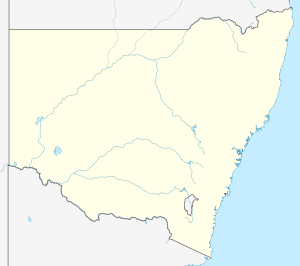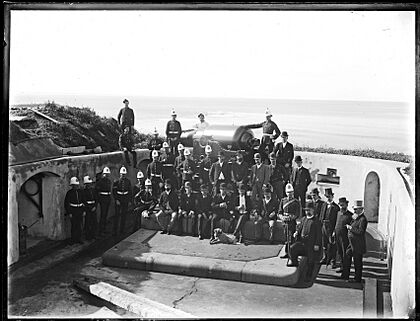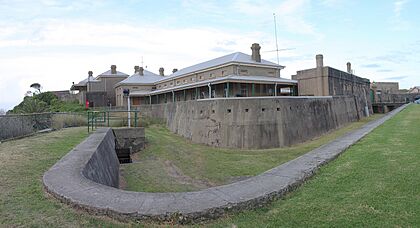Fort Scratchley facts for kids
Quick facts for kids Fort Scratchley |
|
|---|---|
| Newcastle East, New South Wales | |
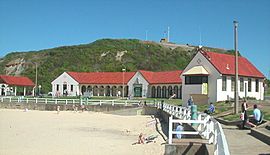
Fort Scratchley (on hilltop) viewed from Nobbys Beach
|
|
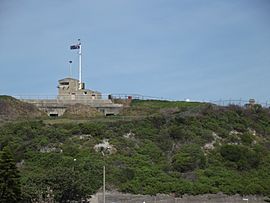
Fort Scratchley in 2011.
|
|
| Coordinates | 32°55′40″S 151°47′26″E / 32.92768°S 151.79045°E |
| Type | Coastal defence installation |
| Height | 30 m (98 ft) |
| Site information | |
| Owner | Newcastle City Council |
| Controlled by | Australia |
| Open to the public |
Wednesday - Monday (closed Tuesday) (10am - 4pm) |
| Condition | Restored |
| Site history | |
| Built | 1882 |
| In use | 1882–1972 |
| Battles/wars | Shelling of Newcastle 1942 |
Fort Scratchley is an old coastal defence fort that is now a cool museum. It's located in Newcastle East, a part of Newcastle, New South Wales in Australia. The fort was built in 1882 to protect the city from a possible attack by Russia.
Interestingly, its powerful guns weren't actually fired in a real battle until June 8, 1942. This happened during the shelling of Newcastle in World War II. The Australian Army stopped using the fort in 1972. Today, it's a popular spot for visitors to learn about history.
Contents
Exploring Fort Scratchley
Fort Scratchley sits high up on Flagstaff Hill. From here, you can see amazing views of the Tasman Sea and the Hunter River. It's less than 1 kilometre (about half a mile) from the main part of Newcastle.
You can get to the fort from Nobbys Road. It's right between Newcastle Beach and Nobbys Beach. Its location was perfect for guarding the entrance to the Hunter River. This made it a very important defence spot.
In 2004, the fort closed for a big makeover. The city hoped to make it a major tourist attraction. There were some delays and extra costs for repairs. However, the Australian Government stepped in to help fund the project. They saw Fort Scratchley as a special part of Australia's military history.
The fort reopened in June 2008, and a museum started operating there by 2009. Now, it's a fantastic place to visit and learn about the past.
Fort Scratchley's Story
How the Fort Began
Flagstaff Hill is famous for being the place where coal was first found in the late 1700s. Lieutenant John Shortland discovered coal fragments there. For many years, the hill was used for exporting coal.
Then, in 1843, the army took over the land. Plans for a full fort started after 1870. This was because people in Newcastle worried about a possible attack from Russia. The fort was finally finished in 1882. By then, the threat from Russia had passed, and Japan became the new concern.
Early Defences
Before the main fort, some cannons were placed on Allans Hill in 1866. These were later replaced with more powerful guns. By April 1878, preparations began for installing four 80-pounder guns. These were ready just a few weeks later.
Designing the Fort
The fort was completed on April 2, 1882. It was designed by Lieutenant-Colonel Peter Scratchley. The fort was named after him! It had three large 9-inch guns and four 80-pounder guns.
Later, in 1889, even more advanced guns were added. These included three 6-inch guns and one 8-inch "disappearing gun." A disappearing gun could hide below ground after firing. This protected it from enemy fire.
The 80-pounder guns were replaced with faster-firing machine guns in 1898. In 1911, two powerful 6-inch Mark VII guns replaced the disappearing guns.
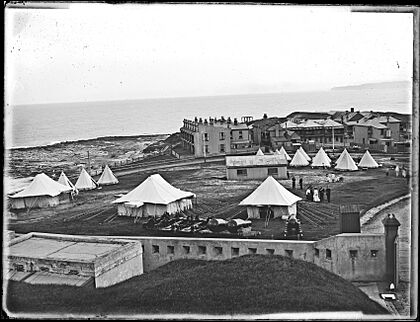
World War I Upgrades
During World War I, the fort was improved. A special Battery Observation Post was built in 1914. This helped soldiers watch for enemy ships.
World War II Action
Fort Scratchley received more upgrades during World War II. The observation post was made bigger. Searchlight stations and blast walls were added in 1942. These helped protect the fort from explosions.
On June 8, 1942, the fort's two 6-inch guns fired at a Japanese submarine called I-21. The submarine was shelling the city of Newcastle. This was the only time the fort's guns were fired in a real battle.
After World War II
After World War II, the fort was used by an army unit. This unit was part of a national service program. The army finally left the site in November 1972.
The 6-inch guns were moved to a park nearby as a memorial. However, after many people asked for them back, they were returned to Fort Scratchley in 1978.
In the early 2000s, the fort had a huge renovation. It reopened as a museum, which you can visit today. In 2014, TV presenter Sir Tony Robinson visited the fort. He filmed a part for his show Tour of Duty there.
In 2015, one of the fort's old Nordenfelt machine guns was fixed. It can now be fired on special occasions from its underground spot.
Where the Cannons Went
Some of Fort Scratchley's old cannons were moved to other places. Two 68-pounder cannons are now in Stroud, New South Wales. An 8-inch disappearing gun was sent to an artillery school for training. Another signal cannon traveled to Georges Heights in Sydney, and then to Puckapunyal Army Barracks in Victoria.
The two main 6-inch Mark VII guns were taken out of service in 1965. They were moved to Obelisk Hill as monuments. But in 1978, they were brought back to the fort. They were put back in their original positions. These guns were restored in 1992. Now, they can be fired on special days for ceremonies and salutes!
One of the smaller Nordenfelt guns was removed in 1910. The other two were moved in the 1930s. All three went to Sydney. However, one was returned to the fort in 1985. It was restored in 2015 and can also be fired on special occasions.
Engineering History
Fort Scratchley has been recognized for its important engineering. It received an Engineering Heritage Marker from Engineers Australia. This award celebrates places that show great engineering achievements.
See also
- Australia–Russia relations


